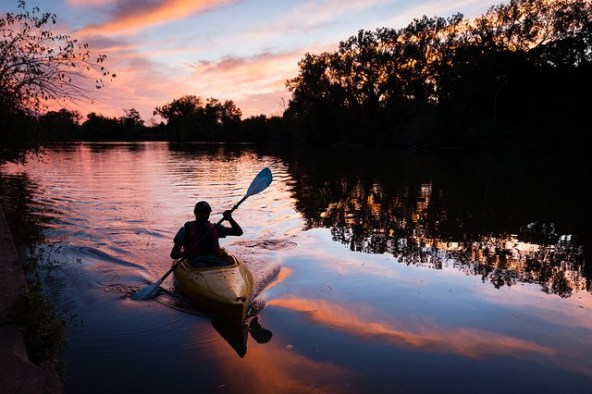A Different Facet of “On-the-Ground”
March 23, 2015
By: CLiGS
“Working on what you care about makes work so much more interesting and fulfilling,” says Mandy Chesnutt, an alumna of the Executive Master of Natural Resources (XMNR) inaugural cohort. “I go home every night knowing I contributed to something bigger.”
In February 2010, Mandy began work at the National Fish and Wildlife Foundation (NFWF), one of the largest national grant-maker non-profits, as the Manager of their Chesapeake Programs. This position consists of managing two grant programs, the monitoring and assessment of these programs, and helps grantees prepare Quality Assurance Project Plans, which outline how they will collect and use data. Mandy also worked with municipalities and nonprofits to develop new projects and build capacity to do restoration and stormwater work to improve conditions in the Anacostia River Watershed, a tributary to the Potomac River and Chesapeake Bay.

“My passion has always been wildlife and nature. I’m not sure what it is about them, but they fire me up more than any other issue,” Mandy says. Once armed with a bachelors degree in Biology with a specialization in Zoology from the University of Maryland, Mandy could only envisage herself working for nonprofits implementing on-the-ground projects, or working for advocacy organizations.
Once it became clear to her that to make the jump from managing projects to program planning, including understanding impacts, directing investments and measuring results, a masters degree was advantageous, so she decided to pursue the XMNR program. Toward the end of her time in XMNR in 2012, she developed a business plan, in collaboration with the then Director of Eastern Partnership Office, “to find specific places in the Chesapeake Bay Watershed where restoration activities could achieve multiple goals around water quality, habitat and species conservation,” which are NFWF’s main priorities. This multi-targeted approach was widely accepted both inside and outside the foundation.
NFWF’s Vice President of Conservation Programs knew Mandy had recently completed her degree, and had seen first hand how it had aided her in the strategic thinking required to develop the Chesapeake Plan and in 2013 Mandy was promoted to Senior Manager of Conservation Programs, where she now develops nationwide programs and plans.

“There’s nothing like having a personal connection to the environment you call home,” Mandy asserts of the link between her work and the Potomac River, the fourth largest river along the U.S. Atlantic coast which flows into the CBW, and where she grew up kayaking and exploring the habitats along its shorelines.
Mandy is currently working on the Hurricane Sandy Coastal Resilience Program, dispersing $102.7 million in grant funding for on-the-ground projects. “NFWF is in a unique position to have funds to do significant amounts of on-the-ground work. Understanding how we direct those funds and choose projects is important. It’s a lens through which [students] might not have looked through before,” she says about the XMNR program’s regular invitations to have her return as a guest speaker to talk to current students about tactical thinking in relation to managing the Chesapeake Bay Watershed issues.
“Before XMNR I had been viewing conservation in somewhat of a vacuum. You do conservation for conservation’s sake,” Mandy says. The program helped her understand bigger issues “like larger scale drivers behind loss of habitat and diversity: poverty, inequality, war, corporate actors, competing interests. They all have an impact on the environment. In order to truly change a dynamic, all of those human factors need to be considered.”
She also maintains that the program helped delve deeper into the impacts of climate change on ecosystems, ecosystem services and human life, which she is now directly applying to her coastal resiliency work. Her team developed a framework for the Hurricane Sandy Coastal Resiliency Grants Program that included the compilation of data and completion of complex GIS analysis to identify communities most at risk from future storms and how natural systems and green infrastructure provide those communities with resiliency.


